- Home
- About Us
- Join/Renew
- Member Benefits
- Member Pages
- Log In
- Help
- Museum Store
I haven’t done this for a while, but here goes my latest project. I am way behind Jim Chase at this point.
Part of my regime on redoing my engine is to chase all of the bolt holes. This helps cure damaged, rusty or otherwise marginal threads. One of the problems I have run into is that when I got to the water gallery cover, I had to deal with 4-5 holes that had snapped off bolts in them. See the white arrow and to the left of it is a broken bolt I tried to hand drill which wandered into the block.
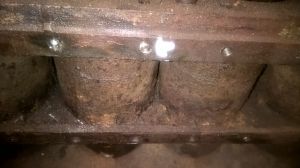
I tried to center punch and hand drill the remaining bolt out with dismal results. Wandering bit, drilling into the side of the block next to the bolt hole, can you spell Heli-coil? etc.
After a little thought I came up with a template solution. It requires a drill press, a ½†block of Ebay sourced aluminum, an 11/16†and ¼†drill bits and a Hanson 5/16-18 bit and tap set.
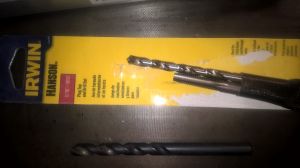
To make the template I used the original side cover plate and a ¼†piece of aluminum that was long enough to cover the distance of 3 consecutive holes in the cover plus ½†extra on each end. Width wasn’t critical but I would think 1†would be a guide. I used ¼†thick plate, but I think ½†would be better.
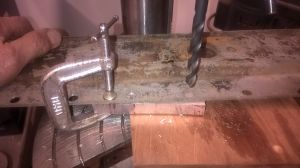
To be able to drill out the remaining bolt fragment requires accuracy. To get that I first clamped the aluminum plate to the back side of the cover and drilled a hole using the holes in the cover as a guide. I started the hole with an 11/32†bit, which is the diameter of the holes in the cover plate. I only drilled until I started to get shavings coming out of the hole. That produces a cavity that is centered in the hole. I did that for 3 holes in a row. I then switched to a 5/16†and drilled all the way thru the first hole using the center point created by the previous bit. I then skipped the next hole and drilled a 5/16†hole in the 3rd hole. I then came back and drilled a ¼†hole in the center hole using the centered point. So 2, 5/16†holes with a ¼†hole between them.

Here is wat the centering “DIVOT”” looks like”

I then bolted the aluminum plate to the block with 5/16-18 bolts with the ¼†hole centered over the broken bolt. Next, start drilling thru the 1/4†center hole with the bit in the Hanson kit, it is an “F†bit or 17/64†(.257â€). I found that if you center drill the broken bolt with an 1/8†bit first, the subsequent drilling with the F bit went much faster and easier. I guess it gives the bit something to grab or it allows chips to be removed. I don’t know the mechanics, but it worked.
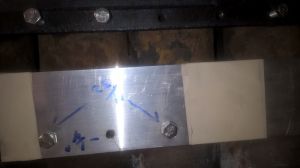
Once done drilling, re-tap the holes. I was lucky enough that the set up drilled close enough to only have the threads left, kind of looked like a slinky. Made very short work of what I thought would be a lengthy process. Now on to the 5 broken bolts in the other block.
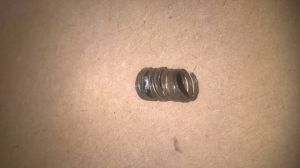
Bill,
The soon to arrive Service Bulletin has an article on this same topic with additional information on thread repair and general cooling system information.
Dave
I need to work on my clairvoyance I guess.
Timing is everything…..
It came from an earlier Message Board thread, so the unedited version is on here somewhere.
Bill,
I had the same problem with the 90+ year-old bolts on my water jacket.
I punched the broken bolt face, drilled with a very small titanium tipped drill bit, then a larger titanium drill bit, then a larger titanium drill bit, etc.
I go the hole large enough to take a good size easy out, soaked the area with penetrating oil, let it sit overnight and tried to remove it.
NOPE!
I then drilled it a bit more to fit a larger easy out, and repeated the operation.
I believe that on the second try, the bolt threads broke loose and I removed the sucker.
On the Series 80 there are 41 water jacket bolts (why 41?), so removing them the first time after ?? years was a challenge.
I believe that I had to do that on a number of WJ bolts.
I also removed about 2-quarts (dry) of ferrous crud from the cooling chamber.
Good luck with your endeavor.
Peter
Something that I’ve tried before in such circumstances and might be worth trying is after you get an accurate starter hole through the broken stump, use a left hand drill bit to enlarge the hole. The left hand spinning of the bit will have a tendency to back out the stump before you get close enough to damage the original block threads.
Left hand bits are available from any machine tool dealer, and undoubtedly can be found on the internet. Unfortunately this is a common problem encountered when removing water jacket covers.
Tom
Note of caution……heat on cast iron in such thin spots can cause cracking ……….it’s never a good idea to heat cast iron with a torch……..too many broken, stripped, and rotted out holes can be a very challenging problem. Good luck.
I have welded a nut to the broken stud and have had succeed a few times but only on ez to get to not standing on your head juggling chain saws good luck
You can also use dry ice to shrink the bolt in the rare case they are proud of the casting.
I have found that welding a flat washer in this case a 1/4″ to what’s left of the bolt even if below the surface and then welding a nut to they washer seems to work better for me since I don’t have to aim the mig through the thickness of the nut. Jim L”
Good Idea Jim, I’ll try that on my next broken jacket bolt..
Greg
David White,
Finally got my Service Bulletin. Great article!! Thanks to all who make these type of documents possible.
Based on Greg Long’s fine thread comment, I guess the factory realized the folly of their ways as both my ’33 and ’35 blocks have coarse threads.
Bill,
Thanks for the good words. That one was a joint effort by a lot of folks. I just organized it. If you have any topics you would like to see in the PASB, let me know. It’s even better if you want to write something.
I think I recall seeing on here at some point you are a Morgan owner. I have a Plus 8.
Dave
Probably should do the bevel rear end rebuild. I just found some new specs tho aid with the build
I love +8’s. Kind of the opposite of a Pierce. No weight and a lot of horsepower. I do have some Malvern Iron, ’65 +4 to Super Sport spec, ’57 +4 DHC and a ’73 +8.
The ’65 is ready for a reenactment of ’62 under 2 liter outright win at Le Mans and the other 2 are piles of parts with frames and numbers. A little difference in weight and dimensions verses my 836
